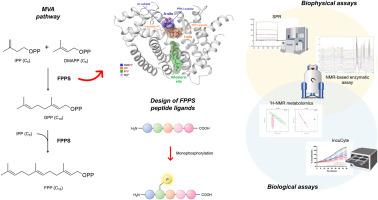当前位置:
X-MOL 学术
›
Eur. J. Med. Chem.
›
论文详情
Our official English website, www.x-mol.net, welcomes your
feedback! (Note: you will need to create a separate account there.)
Peptides as modulators of FPPS enzyme: A multifaceted evaluation from the design to the mechanism of action
European Journal of Medicinal Chemistry ( IF 6.0 ) Pub Date : 2024-09-13 , DOI: 10.1016/j.ejmech.2024.116871
Verdiana Covelli 1 , Michela Buonocore 2 , Manuela Grimaldi 3 , Mario Scrima 3 , Angelo Santoro 4 , Carmen Marino 3 , Veronica De Simone 5 , Lies van Baarle 5 , Francesca Biscu 5 , Maria Carmina Scala 3 , Marina Sala 3 , Gianluca Matteoli 5 , Anna Maria D'Ursi 3 , Manuela Rodriquez 1
European Journal of Medicinal Chemistry ( IF 6.0 ) Pub Date : 2024-09-13 , DOI: 10.1016/j.ejmech.2024.116871
Verdiana Covelli 1 , Michela Buonocore 2 , Manuela Grimaldi 3 , Mario Scrima 3 , Angelo Santoro 4 , Carmen Marino 3 , Veronica De Simone 5 , Lies van Baarle 5 , Francesca Biscu 5 , Maria Carmina Scala 3 , Marina Sala 3 , Gianluca Matteoli 5 , Anna Maria D'Ursi 3 , Manuela Rodriquez 1
Affiliation

|
Bone diseases are medical conditions caused by the loss of bone homeostasis consecutive to increased osteoclast activity and diminished osteoblast activity. The mevalonate pathway (MVA) is crucial for maintaining this balance since it drives the post-translational prenylation of small guanosine triphosphatases (GTPases) proteins. Farnesyl pyrophosphate synthase (FPPS) plays a crucial role in the MVA pathway. Consequently, in the treatment of bone-related diseases, FPPS is the target of FDA-approved nitrogen-containing bisphosphonates (N-BPs), which have tropism mainly for bone tissue due to their poor penetration in soft tissues. The development of inhibitors targeting the FPPS enzyme has garnered significant interest in recent decades due to FPPS's role in the biosynthesis of cholesterol and other isoprenoids, which are implicated in cancer, bone diseases, and other conditions. In this study, we describe a multidisciplinary approach to designing novel FPPS inhibitors, combining computational modeling, biochemical assays, and biophysical techniques. A series of peptides and phosphopeptides were designed, synthesized, and evaluated for their ability to inhibit FPPS activity. Molecular docking was employed to predict the binding modes of these compounds to FPPS, while Surface Plasmon Resonance (SPR) and Nuclear Magnetic Resonance (NMR) spectroscopy experiments – based on Saturation Transfer Difference (STD) and an enzymatic NMR assay – were used to measure their binding affinities and kinetics. The biological activity of the most promising compounds was further assessed in cellular assays using murine colorectal cancer (CRC) cells. Additionally, genomics and metabolomics profiling allowed to unravel the possible mechanisms underlying the activity of the peptides, confirming their involvement in the modulation of the MVA pathway. Our findings demonstrate that the designed peptides and phosphopeptides exhibit significant inhibitory activity against FPPS and possess antiproliferative effects on CRC cells, suggesting their potential as therapeutic agents for cancer.
中文翻译:

肽作为 FPPS 酶的调节剂:从设计到作用机制的多方面评估
骨病是由于破骨细胞活性增加和成骨细胞活性降低而引起的骨稳态丧失引起的疾病。甲羟戊酸通路 (MVA) 对于维持这种平衡至关重要,因为它驱动小鸟苷三磷酸酶 (GTP 酶) 蛋白的翻译后异戊二烯化。法尼基焦磷酸合酶 (FPPS) 在 MVA 通路中起着至关重要的作用。因此,在骨相关疾病的治疗中,FPPS 是 FDA 批准的含氮双膦酸盐 (N-BPs) 的目标,由于它们在软组织中的渗透性差,主要对骨组织具有趋向性。由于 FPPS 在胆固醇和其他类异戊二烯的生物合成中的作用,靶向 FPPS 酶的抑制剂的开发在近几十年来引起了人们的极大兴趣,这些异戊二烯与癌症、骨骼疾病和其他疾病有关。在这项研究中,我们描述了一种设计新型 FPPS 抑制剂的多学科方法,结合了计算建模、生化测定和生物物理技术。设计、合成了一系列肽和磷酸肽,并评价了它们抑制 FPPS 活性的能力。采用分子对接来预测这些化合物与 FPPS 的结合模式,而表面等离子体共振 (SPR) 和核磁共振 (NMR) 波谱实验——基于饱和转移差 (STD) 和酶促 NMR 测定——用于测量它们的结合亲和力和动力学。在使用小鼠结直肠癌 (CRC) 细胞的细胞测定中进一步评估了最有前途的化合物的生物活性。 此外,基因组学和代谢组学分析可以揭示肽活性的可能机制,证实它们参与 MVA 通路的调节。我们的研究结果表明,设计的肽和磷酸肽对 FPPS 表现出显着的抑制活性,并对 CRC 细胞具有抗增殖作用,表明它们作为癌症治疗剂的潜力。
更新日期:2024-09-13
中文翻译:

肽作为 FPPS 酶的调节剂:从设计到作用机制的多方面评估
骨病是由于破骨细胞活性增加和成骨细胞活性降低而引起的骨稳态丧失引起的疾病。甲羟戊酸通路 (MVA) 对于维持这种平衡至关重要,因为它驱动小鸟苷三磷酸酶 (GTP 酶) 蛋白的翻译后异戊二烯化。法尼基焦磷酸合酶 (FPPS) 在 MVA 通路中起着至关重要的作用。因此,在骨相关疾病的治疗中,FPPS 是 FDA 批准的含氮双膦酸盐 (N-BPs) 的目标,由于它们在软组织中的渗透性差,主要对骨组织具有趋向性。由于 FPPS 在胆固醇和其他类异戊二烯的生物合成中的作用,靶向 FPPS 酶的抑制剂的开发在近几十年来引起了人们的极大兴趣,这些异戊二烯与癌症、骨骼疾病和其他疾病有关。在这项研究中,我们描述了一种设计新型 FPPS 抑制剂的多学科方法,结合了计算建模、生化测定和生物物理技术。设计、合成了一系列肽和磷酸肽,并评价了它们抑制 FPPS 活性的能力。采用分子对接来预测这些化合物与 FPPS 的结合模式,而表面等离子体共振 (SPR) 和核磁共振 (NMR) 波谱实验——基于饱和转移差 (STD) 和酶促 NMR 测定——用于测量它们的结合亲和力和动力学。在使用小鼠结直肠癌 (CRC) 细胞的细胞测定中进一步评估了最有前途的化合物的生物活性。 此外,基因组学和代谢组学分析可以揭示肽活性的可能机制,证实它们参与 MVA 通路的调节。我们的研究结果表明,设计的肽和磷酸肽对 FPPS 表现出显着的抑制活性,并对 CRC 细胞具有抗增殖作用,表明它们作为癌症治疗剂的潜力。

































 京公网安备 11010802027423号
京公网安备 11010802027423号